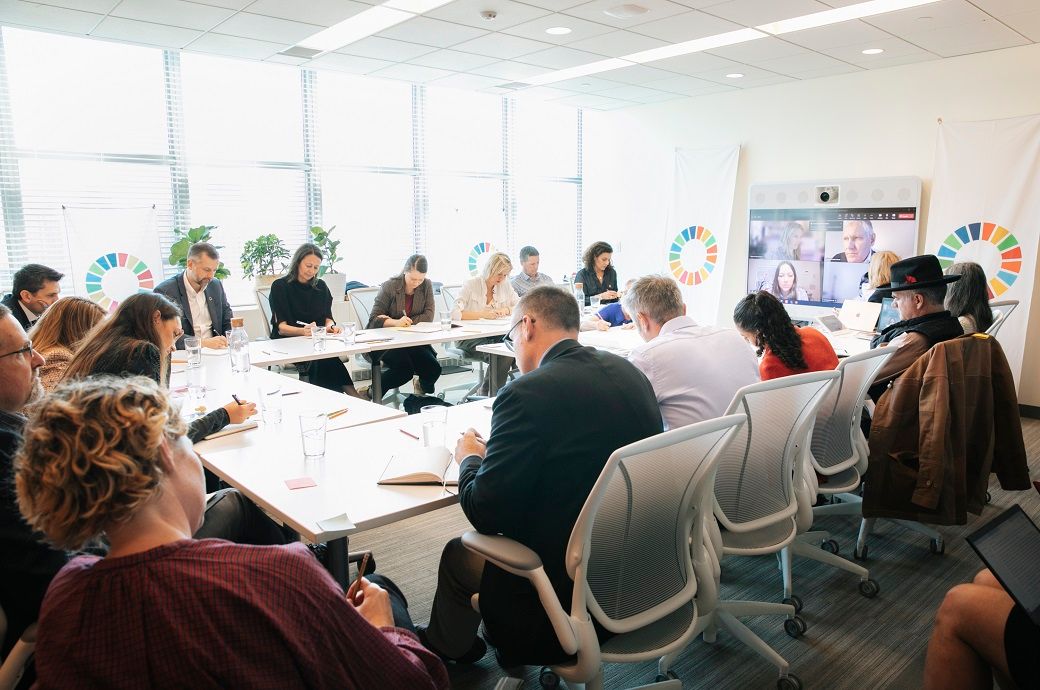Representatives of WCTD co-founding organizations, including Circle Economy (Netherlands), Center for Circular Design (London) and Worn Again Technologies (UK), together with Lenzing Fibers (USA) and in collaboration with the United Nations Conscious Fashion and According to the press WCTD release, Lifestyle Network hosted a Circular Textiles Roundtable with key stakeholders from across the circular landscape, including textile collectors and sorters to brands/retailers, industry associations and policy makers.
To mark the 3rd annual WCTD on 8 October 2022, an action-oriented roundtable with a select group of industry pioneers convened at United Nations Headquarters in New York to identify realistic and achievable priority milestones for the next three years. decades to create the basis for a road map to the full textile cycle.
The United Nations Conscious Fashion and Lifestyle Network, a joint initiative of the Fashion Impact Fund and the United Nations (UN) on Partnerships, is the UN’s online platform for industry stakeholders, media, governments and UN system organizations to showcase collaboration that accelerates the Goals sustainable development.
Participants came together to develop and complete a roadmap for textile circularity to 2050, identifying key milestones to move from the current linear model of “make, use and waste” to a circular one, where products and materials are in continuous circulation, and replace the use of virgin materials, and industrial workers are supported in fair, socially just and sustainable societies.
The roundtable took a systems thinking approach to the future on three main themes: materials and planetary boundaries, products and services, and people and society, and on three different phases of development over the next three decades.
“The scale of change required to transition to a fully circular textile industry is huge, but it can be broken down into small and achievable milestones and delivery plans. Developing and aligning circular strategies for implementation and action across the industry today is critical to achieving future goals and delivering beneficial outcomes for society, the economy and the environment in equal measure. Convening these dedicated industry leaders to develop collective knowledge and strengthen relationships is a critical step in fast-tracking the changes needed,” shared Cindy Rhodes, founder of Worn Again Technologies, co-founder of WCTD.
“The United Nations Conscious Fashion and Lifestyle Network promotes transparent, inclusive and transformative engagement among global stakeholders to take immediate action for sustainable development. The Circular Textiles Roundtable was in line with our goal of mobilizing expertise, innovation, technology and resources for a sustainable and inclusive recovery from COVID-19 with the Sustainable Development Goals as a guiding framework,” added Kerry Bannigan, Executive Director of the Fashion Impact Fund.
Key insights from some of the industry’s leading pioneers included:
Technology: A clear, streamlined scale-up plan is needed between now and 2050 for all stages of collection, sorting, pre-treatment and recycling.
Scope 3: Education, training, new investment and business models are needed to transform the supply chain, including multi-stakeholder models for ownership and distribution.
Data/Digitalization: A data-driven approach needs to be implemented as soon as possible to ensure greater understanding and efficiency of circular flows.
Policy: Development of government policies for micro, meso and macro activities involving coordination between global North and South actors.
Overall, the group expressed a desire to see “stakeholder turbo-collaboration” and forge more partnerships at a faster pace. They also noted the lack of information and action around the potential of social innovation for the circular textile industry and asked for more information on realistic and fair proposals for transformation, the release added.
“Witnessing textile industry leaders coming together at the United Nations to participate in joint exercises and conversations on circularity, in itself speaks to the urgency and need to work together to create systems and guidelines to achieve this common goal. In particular, I remember one participant saying, “We need to go faster. Let’s get on with it now,” commented Tori Piscotelli, Regional Marketing Manager for Lenzing Fibers.
“At Accelerating Circularity, we call ourselves the ‘Do Tank’ and ask everyone we work with to contribute their knowledge and energy to making the textile-to-textile circular transition possible. This is not enough. At WCTD 3 key systems, products and services, materials and people were highlighted as important. To enable a cyclical process, we must align all strategies to implement and accelerate this necessary revolution. “Action”, “change”, “fast” are the descriptors we use for the textile industry. Let’s show the world that we can take the necessary steps to change quickly and create a textile industry worthy of the needs of our industry and the world,” added Carla Magruder of Accelerating Circularity.
The roadmap template will be published in the coming months and will be used as a basis for integrating existing industry commitments on circularity and decarbonisation, as well as establishing a long-term framework on a range of topics including transparency, traceability, social performance, legislation, design, circular materials, and products and services. The aim of the roadmap is to focus the industry on concerted actions that accelerate the cycle, while supporting the industry to meet its climate targets and meet the many UN Sustainable Development Goals.
Fibre2Fashion News Service (NB)
This article is first published on Source link
